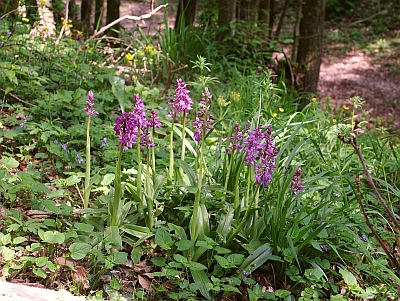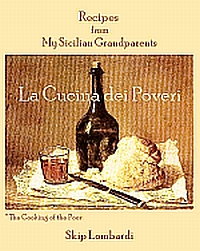Suspect Salep
February 10th, 2010
The 1989 edition of The Oxford English Dictionary cites this 1712 usage of a powdered orchid root used to make a warm winter beverage.
As I write this, Washington, DC has white-out conditions. We know that many of our readers are buried by a blizzard and home from work and school. The novelty of Snowmaggedon may not yet be melting, but we offer a little diversion and something deliciously warming.
This post will lead readers out of the snowdrifts, on a ramble through history via flower-strewn meadows and cinnamon-scented kitchens in the Middle East. Stick with us and you’ll end up with a cup of comfort that has more than a little lore behind it, one that is singularly appropriate for Valentine’s Day.
In Turkey, Iran, and throughout the countries of the eastern Mediterranean, salep has a long been enjoyed as a wintertime beverage—milk boiled with sugar and a very small amount of powdered orchid tuber known as salep. Usually identified as Orchis mascula, though many other terrestrial orchid roots have very similar qualities, salep contains the polysacchyride, bassorin, which swells and thickens a heated liquid in the same fashion as arrowroot or cornstarch. When the hot milk-salep mixture reaches the consistency of a thin potato purée, it is served in cups. Each serving is traditionally dusted with ground cinnamon.
Though people in the Mideast do make the drink at home, connoisseurs seeking a light, warm, liquid meal seek salep in pastry shops or from pushcarts, where it is dispensed from huge brass urns.

Turkish Salepci
The orchid tuber powder itself is nearly tasteless and, in warmed milk, its thickening qualities are not readily distinguishable from other starches. Starches derived from sago, potato, corn, and arrowroot (though not of Mideastern origin) are now widely available and far cheaper than salep, which in its pure state can cost hundreds of dollars per pound. It is for this reason that the instant salep packets most homemakers now buy are so light on salep, with cornstarch and sugar being the primary ingredients.

Yet, packages of most brands still include an infinitesimal amount of the orchid root—or at least they say they do. But why bother? Is this like the whisper of goose liver in tinned patés of pork liver, a trace element of a delicacy lending credibility to the ordinary?
I first gave serious thought to the uses of Orchis mascula two decades ago when I gave a lecture on salep at Oxford. I’ll spare you some of that, but first, a little grounding in ancient Greek and Classical Arabic before we proceed to the recipe for a drink reputed to be a veritable elixir of love.
The word “orchid” stems from the Greek orkhis, or testicle, a reference to the fleshy roots of this family of epiphytes and terrestrial plants. Our subject, Orchis mascula is native to much of Europe and is widespread from the Canary Islands through the entire Mediterranean, Asia Minor and Levant, where I have come to know it as a culinary ingredient.

Orchis mascula
It’s Arabic name is khasyu ‘th-thalab, or fox’s testicles. The th of Classical Arabic tends to become s in popular speech, and salep is nothing more than the word for “fox.” With myriad European spellings, saleb, sahlab, salob, saloop, salub… the beverage was extremely widespread in the 17th and 18th centuries, when fascination and trade with the Levant was especially robust. Particularly prized were the costlier tubers imported from the East.Europeans and the British often made do with those of their own orchids, suggestively classified as “satyrions.”
It doesn’t take much imagination to wonder if plants with such an etymology have had medicinal properties ascribed to them. And indeed they have. From the 3rd century BC writings of the Greek naturalist Theophrastus to a funky 1970 California cookbook on aphrodisiacs to the age of internet searches for “botanical Viagra,” the media abound with the supposed benefits of orchid roots.
The reputation of salep is colorfully inconsistent. Theophrastus’ reports that when mixed with goat’s milk, the tubers will grant prodigious male sexual powers. Victorian writers recommend salep for children and convalescents. From both fabulous and mundane accounts, it is clear that salep drinks were considered restorative; they were even suggested as an antidote to alcoholism.
Local orchids of the British Isles, their roots known as “dogstones,” were evidently abundant and cheap enough to serve the working classes. Salep was deemed a good breakfast for a chimney-sweep. Early in the industrial age, London salep-stalls were plentiful before their eclipse by coffee-shops. Patronized by laborers both late at night and early in the morning, the stalls were places to sober up and gain strength for the day ahead.
At the other end of the social spectrum, Gastronomie Larousse (1961) gives a recipe for potage au salep that can be passed off as the costly delicacy, bird’s nest soup. This gives us a clue as to notions of supply, demand, and celebrity in comestibles. Take two items from the gourmet ingredients list of Chinese cuisine, birds’ nests and shark fins. Both, like salep, add gelatinous texture—but scant flavor—to liquids. And again, like salep, they have been touted as aphrodisiacs. All three are in limited supply (from over-harvesting or destroyed habitats) and are correspondingly costly. As a vintage wine or stamp collector will tell you, rarity plays a part in the appeal of any luxury or collectible and, in the case of aphrodisiacs, helps to sustain their reputations.
I find no discernible difference in taste or mouth-feel between hot salep made with the precious powdered orchid root and faux salep made with cornstarch, the cheapest substitute. As noted, these days, the commercial salep powders are mostly cornstarch with sugar and vanilla flavoring. If you’re an endangered orchid, this should be good news, except that folk-beliefs die hard and if consumers demand genuine orchid roots, wild orchids will continued to be poached to satisfy demand for the aphrodisiac. Turkey, with its extraordinary bio-diversity (over 9,000 different plant species, including at least 148 species of orchids) and vast, sparsely populated areas, is especially vulnerable.
Luckily, environmental awareness and conservation projects are beginning to take hold in Turkey. Projects to employ local inhabitants in the cultivation of endangered orchids and other flora are now underway. Join us there in April and see for yourself.

Orchis mascula in the wild
As a Valentine to the country that has taught me so much about food, here’s a recipe for salep and my declaration that NO ORCHIDS WERE HARMED to bring you this post.
SALEP
2 Tbs. cornstarch
4 Cups milk ( whole or reduced fat, but not skim)
3 Tbs. granulated sugar, or more to taste
1 tsp vanilla extract OR 2 tsp rose or orange-blossom water
Ground cinnamon
Into a small prep-bowl, sieve the cornstarch through a tea-strainer to remove any lumps. Stir 5 or 6 tablespoons of the milk into the cornstarch to make a smooth paste. Set bowl aside.
In a saucepan, bring the remaining milk, uncovered, to a boil. Just as it begins to boil, reduce heat to low.
Stir in the sugar and pour in the starch mixture, stirring vigorously, so that lumps do not form.
Cook over very low heat, stirring continuously, until the milk thickens, about 8-10 minutes.
Remove mixture from heat. Stir in one of the flavorings* suggested.
Serve salep in cups or mugs and dust each with cinnamon.
Setting its reputation as an aphrodisiacs aside, the most remarkable quality of salep is the elastic quality it imparts to chilled liquids. (Imagine room-temperature cheese fondue!) Churned from the milk of water-buffaloes, the renowned salep ice-cream of the orchid-rich region of Marash, in southeastern Turkey, has enough body to be hung up on a line, like a damp towel. But that’s a story for another day, one with sunshine and higher temperatures!
Tune in later this spring, after the botanical tour to Turkey that will be led by Sarasota orchidologist, Stig Dalstrom.



